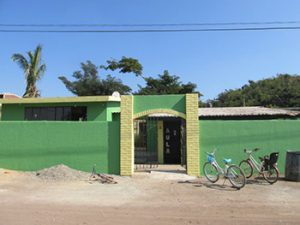Retired Foster alumni give back to community in Mexico

John and Elise Lindseth
Ahh, retirement. That long-awaited reward for a life of hard work.
In the earliest stages of their “golden years,” John (BA 1976, EMBA 1987) and Elise (BA 1976) Lindseth are splitting time between homes in southern California and in a small town on the breathtaking Pacific coast of Mexico between Manzanillo and Puerto Vallarta.
But for John, who recently closed out a career as vice-president at Nutrilite, and Elise, a 34-year veteran of Boeing, retirement has been anything but idle. The good life for them means doing good in their adopted seaside community in Mexico.
Restoring sea life
It began when local fishermen approached John to ask if he might help restore the region’s disappearing fish populations which were threatening the primary livelihood of the village. He and an American neighbor set out to create a marine sanctuary project that would restore and protect the coastal ecosystem.
John and Elise reached into their deep stores of management experience to make it happen.
To get buy-in from the local fishermen’s cooperative, they hosted a meeting with government officials and the director of the Marine Reserve near Cabo San Lucas. This meeting helped the fishermen understand that carving out a small zone where fishing was not allowed would help repopulate the larger coastal waters. The fishermen were reluctant at first, but over time came to support this initiative.
John, Elise and their neighbor raised $30,000 to hire experts to map out a viable no-fishing zone. Once it was identified, they applied to certify this zone as a Marine and Coastal Protected Area (MCPA). The local fisherman agreed not to fish this area until it is declared an official marine reserve, hopefully by 2018.
Turtle time
Fish were not the only wildlife to have disappeared in recent years from this stretch of coastal Mexico. The sea turtle population had also been decimated. Though an estimated 5,000 turtle eggs incubate at any time on the beaches of nearby Coasta Alegre, most are poached or eaten by predators before they hatch.
To solve this dilemma, the Lindseths helped to set up “no kill zones” with the hope of eventually creating an official marine sanctuary here as well. They, along with their local friends, have saved several thousand turtles by releasing them into the water before a poacher or predator gets to them.

The school after it was painted
After the storm
Progress on the marine sanctuaries took a major hit when Hurricane Patricia battered the Lindseth’s seaside town in October 2015. At first, they considered diverting efforts and resources earmarked for sanctuary development to help the town rebuild. But thinking of the long-term good, they decided that the sanctuary would be essential to sustain the town’s residents for years to come. Plans needed to press forward.
But that doesn’t mean they neglected other areas of need in their new community. In the aftermath of the hurricane, John and Elise mobilized 25 local volunteers and several fellow ex-pats to raise $10,000 toward rebuilding the town’s school, leaving it in better condition than it was before the hurricane hit.
Still, they went further. After the storm damaged a septic system, causing it to leak next to the school, John sent water samples to be analyzed in the U.S. The report revealed that the children were being exposed to dangerous contaminants in the water.
By identifying this critical health risk, the leaking septic system became a top priority to be repaired. And the area near the school was cleaned of contaminants.
Deeper meaning
John and Elise have decided to view retirement as more than reward. They view their home in this idyllic little stretch of the Mexican coast as more than a place to relax. They have become fully invested and ingrained in their new community, which comes with its own kind of reward.
Namely, the local fishermen and their families who constantly stop by to say hello.
“We’re just helping our neighbors,” Elise says.
The Lindseths are happy they can leverage their resources and skills to help their community become more livable and sustainable. They hope to see the town’s children grow up with pride and purpose.
“Our work here allows us to be more purposeful,” John says. “We can do something—anyone can do something. It’s about giving back.”
